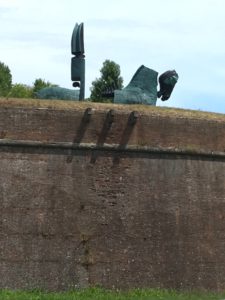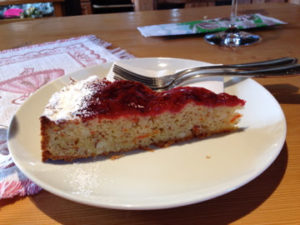
In italiano a: https://luccalife.com/finalmente-italiano-non-perdere-le-nostre-notizie-iscriverti-luccalife-com/
ON VIEW NOW: A Rare Luminous Glimpse into Nomellini’s Evolution
Thru November 5, 2017
Palazzo Mediceo – Seravezza (LU)
Seravezza, the site of the Nomellini exhibit, is an easy and lovely escape from the city into the mountains — just 30 minutes away on A11. We highly recommend that you combine this great cultural experience with a gastronomic one as well. Check the exhibit hours before you go so that you can see the show after 5 pm and follow it with an exceptional dinner at the Communist Club in Solaio — officially, the Circolo ARCI. Yes, we said it was Communist, but it is now socialist in name alone, and reservations are a definite must on weekends. It’s the perfect place to hang with your friends and family because they handle crowds like pros. You will be amused by the Che Guevara fresco that greets you at the front door, but you will be astounded by the home-made tordelli con sugo (Lucchese meat-filled ravioli with meat sauce) that are probably the best that this author has ever tasted — except for my Nonna’s!
The experiences of war and dictatorship have plunged many an artist into exhortative depictions of horror and despair. Yet others, like Plinio Nomellini, the subject of a stunning retrospective at the Medici Foundation in Seravezza (LU), Italy, found the inspiration to celebrate the beauty of life’s everyday moments despite political events.
With her show Plinio Nomellini – From Divisionism to Symbolism toward the freedom of color, Curator Nadia Marchione gives light to rarely seen pieces from private collections, as well as the Archivio Nomellini in Florence, and the Uffizi. While the painter was widely respected in Italy throughout his career as he is today, Nomellini, like the Macchiaioli who mentored him, is hardly known outside of Italy. This beautiful collection offers an extraordinary chance to learn about his evolution as a painter.
Over the course of his long life (1866-1943) Nomellini synthesized a Romantic sensibility with Pointillism strokes, and Expressionist intensity, to celebrate family and friends captured in bucolic settings, even as Italy rode the emotional and economic rollercoaster of its Unification, World War, Depression and Fascist euphoria thru the early 20th century.
The Romantic poet Giovanni Pascoli, the Decadent writer and political activist Gabriele D’Annunzio, Giacomo Puccini, Futurist Lorenzo Viani, Nobel prize winning author Grazia Deledda, and Macchiaiolo Giovanni Fattori were only a few of the friends with wildly divergent views who frequented Nomellini’s salons and who influenced him.
A frequent exhibitor at the Venice Biennale, “Nomellini was the artist who most courageously introduced the study of the divided brushstroke to Italy, borrowing the French pointillist theory on juxtaposing pure colors on a canvas, and translating it into an absolutely personal language,” says Ms. Marchioni.
Nomellini’s canvases are luminous, and often huge, capable of immersing the viewer in a joyous, quasi-mythic world. As the Carlo Sisi, of the Fondazione Medicea says, the chronological progression of the exhibit permits viewers to see and learn from the evolution of a master’s vision as he seeks to express the “profound, impassioned, and mysterious” nature of the human spirit.
ABOVE: “Kisses of the Sun” or “Baci di sole, 1908,” one of the featured paintings by Italian impressionist Plinio Nomellini, exhibited at the Palazzo Mediceo in Seravezza thru November 3rd.

ABOVE: The exhibit is housed in a 15th century Medici palace which straddles the valley in Seravezza.


